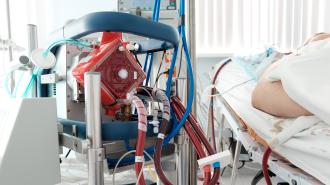A new device that lets researchers precisely control the brain’s blood supply could lead to new neuroscience breakthroughs and save the lives of patients undergoing heart surgeries.
The brain’s blood: The brain is your body’s command center — it controls the biological functions that keep you alive, like breathing and your heartbeat, while also giving you the ability to move, think, and feel.
Your brain doesn’t operate in isolation, though — its function is affected by the blood that enters it (something anyone who’s ever had a few alcoholic drinks knows firsthand).
“This novel method enables research that focuses on the brain independent of the body.”
Juan Pascual
Being able to precisely control the brain’s blood supply could be useful to researchers — they might learn more about how diabetes affects brain health, for example, by raising or lowering glucose levels in blood as it enters the brain of a lab animal.
Currently, if they want to do this, they’d need to change the glucose level of the blood throughout the animal — by injecting it with insulin, for example — and the way other parts of the body react to that change could affect how the brain responds, too.
What’s new? A team led by UT Southwestern (UTSW) Medical Center researchers has now developed a device, called FlowChoice, that makes it possible to isolate the brain from the rest of the body so that precise adjustments can be made to its blood supply.
“This novel method enables research that focuses on the brain independent of the body, allowing us to answer physiological questions in a way that has never been done,” said study leader Juan Pascual.
How it works: FlowChoice redirects blood from the heart to an external pump where the levels of oxygen, nutrients, and more in it can be adjusted. Before sending the blood into the artery that delivers it to the brain, researchers can also dictate the temperature, blood pressure, and volume.
To test the device, the researchers anesthetized two pigs and hooked them up to the machine. They then studied the animals’ brains for five hours and saw minimal to no changes in brain activity or function while they received blood through the device.
UTSW’s device can mimic the pulsing flow of blood coming from the heart.
A step up: Cardiopulmonary bypass (CPB) devices — the heart-lung machines used during heart surgeries — work similarly to the new device, oxygenating and cleaning blood before sending it to the brain.
They don’t give doctors the ability to make as many precise adjustments to the brain’s blood supply as the new machine, though. Additionally, UTSW’s device can mimic the pulsing flow of blood coming from the heart, while CPB devices deliver blood continuously, which can affect how it’s received by the brain.
“Heart-lung machines … induce cognitive abnormalities and brain injury in a significant number of persons who undergo various types of surgery,” Pascual told Freethink.
Looking ahead: The UTSW team says research to use the device to study the effects of low-blood sugar on the brain is “underway,” though they declined to clarify in what type of animal.
They’re hopeful the ability to control the brain’s blood supply could be useful in future research and potentially even lead to the development of better CPB devices, ensuring the brain gets the same supply of blood it’s used to while surgeons work on the heart.
“The device (which is comprised of a control algorithm and a pump mechanism) is undergoing steps to enhance its value as both a scientific research tool and as a potential improvement upon current heart-lung machines,” Pascual told Freethink.
Update, 11/30/23, 9:30 am ET: This article was updated to include input from study leader Juan Pascual.
We’d love to hear from you! If you have a comment about this article or if you have a tip for a future Freethink story, please email us at [email protected].






